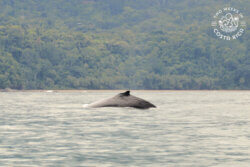Last Updated: August 1, 2025
Costa Rica is probably best known for its wildlife on land. Monkeys, sloths, birds, and butterflies often steal the show and for good reason. But what some forget is that the waters right offshore are full of life too. Sea turtles, tropical fish, dolphins, and whales all frequent the waters of Costa Rica’s two coasts. In this post, we’ll focus on whales, specifically humpback whales, and let you know when and where you can spot these gigantic, mystical mammals.
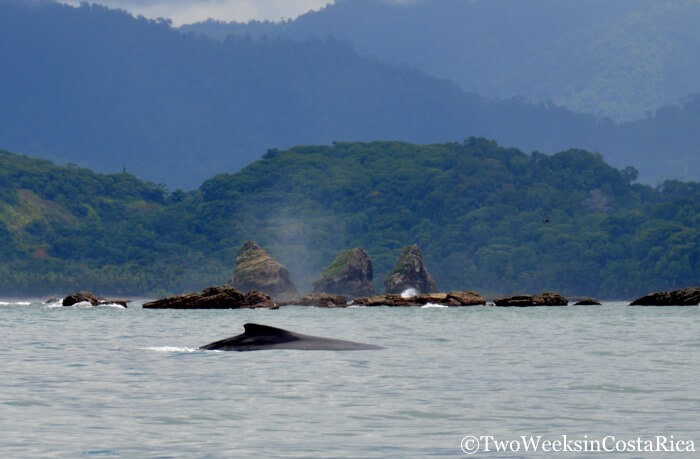
Whale Migration
Costa Rica is a prime whale watching destination. This is all thanks to the spectacular annual migration of two groups of humpback whales.
This long journey starts when temperatures in both North and South America start to cool during their respective winters. Humpbacks quickly head toward the equator where waters are warmer—and Costa Rica is one of their favorite spots.
An amazing fact is that this migration is the longest of any mammal in the world, spanning a distance of up to 5,160 miles (8,300 km). These whales can go fast too, and one was recently recorded by NOAA as making a 3,000 mile (4,830 km) trip in only 36 days!
Once the whales get to Costa Rica, it’s not just about vacationing in the sun.
Humpbacks congregate together and use the months that they are here to find suitable mates, breed, and rear young. The temperate waters are thought to be ideal for the growth of baby whales, even though they can already be 13-16 feet (4-5 m) long and weigh up to 1 ton (907 kg) at birth.
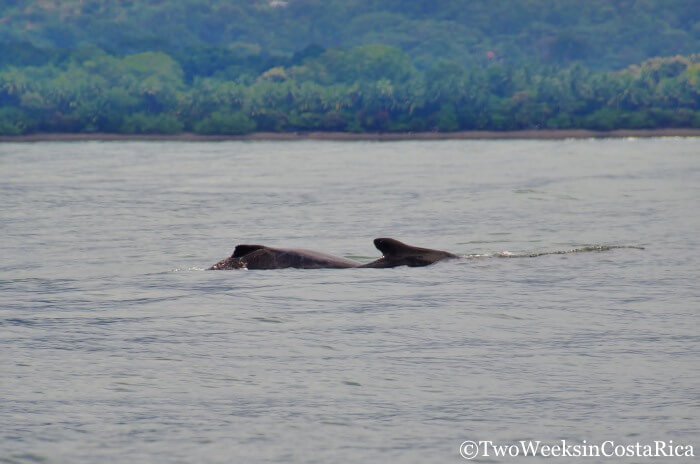
When You Can See Whales in Costa Rica
As we mentioned, there are two different migrations for humpback whales: one from areas to the north like Alaska and California and another from the Antarctic zone to the south. These migrations happen at different times of year but don’t overlap.
Northern humpbacks typically start to arrive in Costa Rica in late December and can be seen until around April. Southern ones don’t show up until mid-July and stay until the beginning of November.
This means that in Costa Rica, there is a chance of seeing humpback whales for nine months out of the year!
These two migrations don’t draw the same number of whales, though, so read on to find out the best time of year to see these amazing creatures.
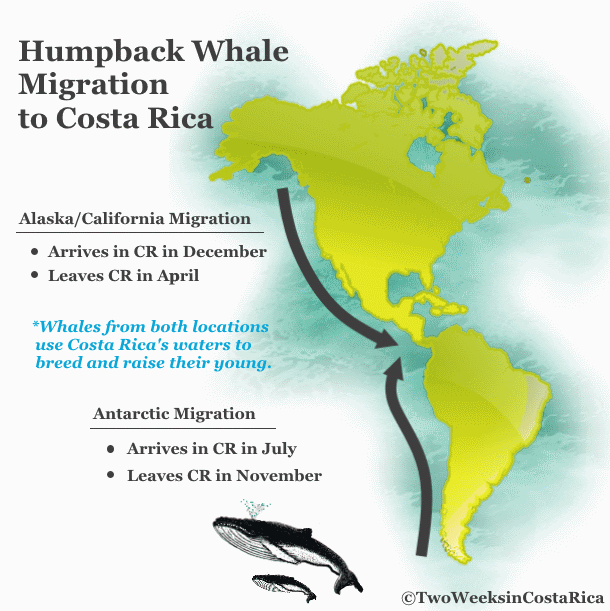
Quick Facts
- The Antarctic migration has the most whales and peak season is between August and October. During this time of year, your odds of seeing a humpback whale are good.
- Some Alaska/California whales winter in Hawaii and other places to the north, so their numbers are fewer in Costa Rica. This means that it is harder to see humpback whales during the December to April season, but not impossible. Whales are sometimes spotted on tours, especially in late December to early February, but it is more likely to see dolphins, turtles, and seabirds.
- There typically aren’t any humpbacks to see from April through June.
- Humpbacks in the northern Atlantic Ocean also migrate near Costa Rica (on the Caribbean coast) but are not found in great numbers so whale watching isn’t as popular as on the Pacific.
Where to See Humpback Whales in Costa Rica
Although it is possible to see humpback whales along many parts of Costa Rica’s Pacific coast, they tend to congregate in the southern Pacific.
The Osa Peninsula and Gulf of Dulce have high numbers of whales as well as the beach towns of Uvita and Dominical on the Costa Ballena (Whale Coast).
Uvita is probably the town best known for whale watching in Costa Rica. In Uvita’s neighborhood of Bahia Ballena, boats launch right from the beaches of Marino Ballena National Park (the National Whale Marine Park). This is a protected area of both land and ocean, which is known for attracting whales close to shore.
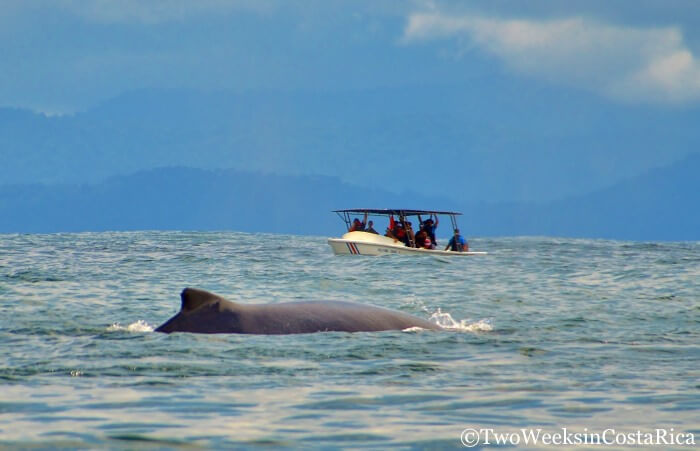
Whale watching tours from Uvita are done on smaller boats, holding about 15-25 passengers. They cost around $80-100 (see booking info below).
The focus of these tours is on whales, but you’re likely to spot dolphins, sea turtles, rays, and other marine life while out on the water as well. These tours also typically include some time for snorkeling.
While tours devoted to whale watching are most common in the Southern Zone, if you’re visiting areas in northern Costa Rica, like Guanacaste, you might still be able to witness these giants passing through. Humpbacks or other types of whales are sometimes spotted on catamaran, snorkel, or dive tours. We have been lucky to spot whales on a catamaran tour from Tamarindo and one from the Flamingo Marina too.
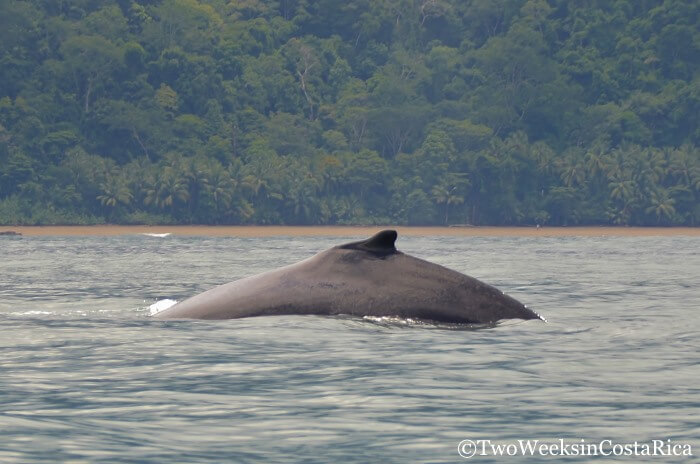
More Facts
- Humpbacks make spectacular displays with their fins and tails and are known to jump out of the water on occasion. Have your camera ready!
- Males compete for females by singing songs, making elaborate bubble displays, and physically fending off one another.
- A baby arrives about 11 months after mating and calves stay by their mother’s side for up to a year. They can often be seen touching fins to show affection.
Booking a Whale Watching Tour in Uvita
We have been booking tours in Uvita for many years. If you’d like to book through the trusted whale watching operator that we recommend, just use the link below. We’ll contact the company and get back to you by email once everything is all set. You won’t pay until your tour is confirmed. Booking through us costs the same and helps support our site!
Cost of Whale Watching Tour
$88 per person adults; $50 per person children ages 4-10. Rates plus 13% tax.
Offered
8:30 a.m. or 1:00 p.m.
*The afternoon tour is only available in December or January because of typical afternoon rain other months.
Duration
3.5 to 4 hours (approximate)
Includes
Bilingual naturalist guide, life jackets, water, tropical fruit, national park entrance fee, and snorkel equipment. Transportation is not included. You will meet at the tour company’s office in Uvita.
Minimum Age
4 years old
Annual Whale and Dolphin Festival
One of the best times to take a whale watching tour is during the Annual Whale and Dolphin Festival in Uvita. This festival happens every year during peak season, typically in early September, so your chances of spotting whales is almost guaranteed.
Abbreviated two-hour whale and dolphin watching tours are given by local tour operators during the festival and there are other events like dancing and music, a beach run, mountain bike race, and lots of activities for kids too.
When we attended the festival, we saw several whales, including a mother and calf, as well as dolphins and a sea turtle. With the beautiful green coastline, the view from the boat alone was worth the price for admission (around $65 pp).
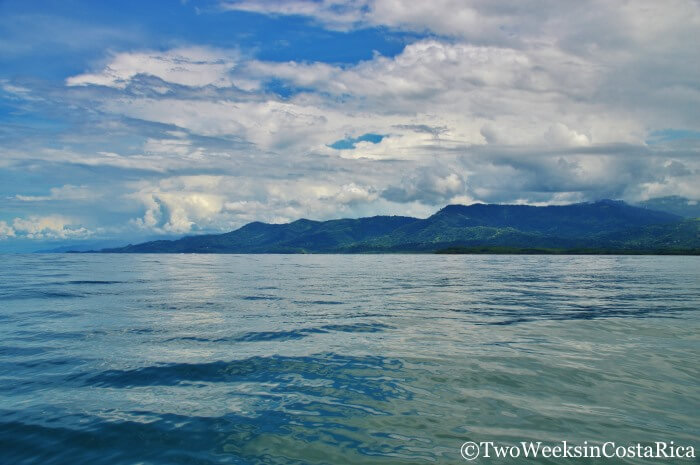
Have you been whale watching in Costa Rica? Leave us a comment below. Where did you go, and what did you see?
Planning a trip to Costa Rica? Check out these posts for more information:
Things to Do in Uvita – Our list of the best activities in Uvita, from visiting a local coffee farm in the hills to learning about coconuts near the beach. For activities all around Costa Rica, see our broader Things to Do category.
Nauyaca Waterfall – Among the Southern Zone’s best attractions, this two-tiered waterfall is one of the most impressive in Costa Rica. And you can jump in to cool off.
Hacienda Baru Wildlife Refuge – A little-known wildlife reserve in Dominical. One of our favorite hiking spots to see monkeys, toucans, caimans, and more.
Uvita Restaurant Guide – If you are staying in the Uvita, read up on these amazing restaurants. Some have been favorites of ours for a decade!
Ocean & Water Activities – Learn about snorkeling in Costa Rica, island tours, dolphin watching, surf lessons, and lots more.




